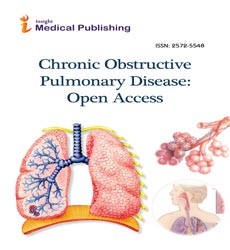Abstract
Detailed Characterization of Hospitalized COPD Patients in Relation to Combined COPD Assessment by GOLD
Background: Detailed characterization of hospitalized COPD patients and their clinical outcomes in Malaysia is lacking. Such understanding is important to combat the rising COPD burden.
Patients and Methods: 120 patients hospitalized for COPD exacerbation in an urban-based state hospital were consecutively recruited. Comprehensive data on socio-demographics, Bristol COPD Knowledge Questionnaire (BCKQ), Hospital Anxiety and Depression Score, clinical parameters, healthcare experiences and hospital outcomes was prospectively collected from medical records and interviews with patients and/or carers.
Results: GOLD A, B, C and D categories consisted of 7 (5.8%), 76 (63.3%), 2 (1.6%), and 35 (29.1%) patients respectively. The mean age (SD) was 68 (10.2) years old and 91% were male. Most had only primary school education and low incomes. Most were smokers and frequent exacerbators. About half smoked ≥40 pack years and 10% had ≥5 exacerbations a year. 55% had no comorbidites. The commonest comorbidity was diabetes (20%). 15.8% had previous TB infection. 6.6% had probably ACOS. Over half were treated with inhaled corticosteroids for ≥6 months. Mean BCKQ score was <50%. Anxiety and depression were reported in 14% and 26% respectively. Median length of hospital stay was 6 days. 11.6% had assisted ventilation. 3.3% patients died during the hospital stay. Except for Group C, distributions across categories were similar. Multivariate logistic regressions showed that the likelihoods of assisted ventilation and hospital mortality were increased with arterial pCO2 (adjusted OR 2.63, p<0.01) and respiratory rate (1.73, p=0.01) respectively. Kaplan-Meier estimates showed that GOLD categories (p=0.0125 by log rank test for trend), assisted ventilation (p=0.005) and antibiotic administration (p=0.009) were associated with probability of prolonged hospital stay.
Conclusions: Our findings identified the many areas that can be intervened to improve COPD management. GOLD categories as a combined assessment tool of COPD severity are clinically relevant for hospitalized patients.
Author(s):
Li-Cher LOH, Choo-Khoon ONG
Abstract | Full-Text | PDF
Share this

Google scholar citation report
Citations : 130
Abstracted/Indexed in
- Google Scholar
- China National Knowledge Infrastructure (CNKI)
- Publons
- Geneva Foundation for Medical Education and Research
- Secret Search Engine Labs
Open Access Journals
- Aquaculture & Veterinary Science
- Chemistry & Chemical Sciences
- Clinical Sciences
- Engineering
- General Science
- Genetics & Molecular Biology
- Health Care & Nursing
- Immunology & Microbiology
- Materials Science
- Mathematics & Physics
- Medical Sciences
- Neurology & Psychiatry
- Oncology & Cancer Science
- Pharmaceutical Sciences

